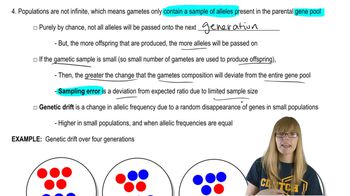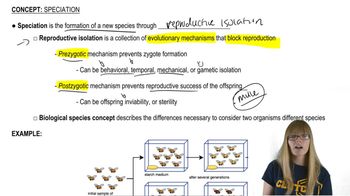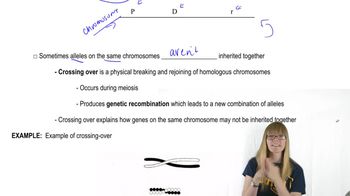Table of contents
- 1. Introduction to Genetics51m
- 2. Mendel's Laws of Inheritance3h 37m
- 3. Extensions to Mendelian Inheritance2h 41m
- 4. Genetic Mapping and Linkage2h 28m
- 5. Genetics of Bacteria and Viruses1h 21m
- 6. Chromosomal Variation1h 48m
- 7. DNA and Chromosome Structure56m
- 8. DNA Replication1h 10m
- 9. Mitosis and Meiosis1h 34m
- 10. Transcription1h 0m
- 11. Translation58m
- 12. Gene Regulation in Prokaryotes1h 19m
- 13. Gene Regulation in Eukaryotes44m
- 14. Genetic Control of Development44m
- 15. Genomes and Genomics1h 50m
- 16. Transposable Elements47m
- 17. Mutation, Repair, and Recombination1h 6m
- 18. Molecular Genetic Tools19m
- 19. Cancer Genetics29m
- 20. Quantitative Genetics1h 26m
- 21. Population Genetics50m
- 22. Evolutionary Genetics29m
4. Genetic Mapping and Linkage
Mapping Overview
Problem 28
Textbook Question
A small population of deer living on an isolated island is separated for many generations from a mainland deer population. The populations retain the same number of chromosomes but hybrids are infertile. One chromosome (shown here) has a different banding pattern in the island population than in the mainland population. Describe how the banding pattern of the island population chromosome most likely evolved from the mainland chromosome. What term or terms describe the difference between these chromosomes?
 Verified step by step guidance
Verified step by step guidance1
Identify the initial condition: The island and mainland deer populations have the same number of chromosomes, but the banding pattern differs, and hybrids are infertile.
Consider the mechanism of evolution: The difference in banding patterns likely arose due to a chromosomal mutation or rearrangement in the island population.
Explore types of chromosomal changes: The change could be due to inversions, translocations, duplications, or deletions, which alter the banding pattern without changing the chromosome number.
Explain reproductive isolation: The infertility of hybrids suggests that the chromosomal changes led to reproductive barriers, a key aspect of speciation.
Define the terms: The difference in banding patterns is an example of chromosomal polymorphism, and the infertility of hybrids indicates postzygotic reproductive isolation.
Recommended similar problem, with video answer:
 Verified Solution
Verified SolutionThis video solution was recommended by our tutors as helpful for the problem above
Video duration:
3mPlay a video:
Was this helpful?
Key Concepts
Here are the essential concepts you must grasp in order to answer the question correctly.
Genetic Drift
Genetic drift refers to the random changes in allele frequencies within a population, particularly in small populations. In the isolated island deer population, genetic drift can lead to significant differences in chromosome structure and banding patterns over generations, as certain alleles may become more or less common purely by chance.
Recommended video:
Guided course

Genetic Drift
Speciation
Speciation is the evolutionary process by which populations evolve to become distinct species. In this case, the isolation of the island deer population from the mainland population can lead to reproductive isolation and divergence, resulting in unique genetic traits, such as the altered banding pattern of chromosomes.
Recommended video:
Guided course

Speciation
Chromosomal Variation
Chromosomal variation encompasses differences in the structure or number of chromosomes between populations. The distinct banding pattern observed in the island population's chromosomes compared to the mainland population indicates chromosomal rearrangements or mutations that have occurred over time, contributing to the genetic diversity and potential reproductive barriers between the two populations.
Recommended video:
Guided course

Genomic Variation

 11:11m
11:11mWatch next
Master Mapping Overview with a bite sized video explanation from Kylia Goodner
Start learningRelated Videos
Related Practice


